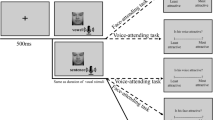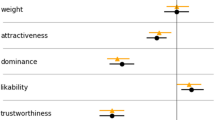Abstract
This article tests hypotheses derived from status-generalization theory and communication-accommodation theory that behaviors resulting from status inequalities emerge when attractiveness differentiates dyads. Relying on unobtrusive acoustic analysis of 24 women's voices, we test the extent to which (1) women adjust nonverbal behavior to one another; (2) more attractive women exert more influence than less attractive partners; and (3) the effects of attractiveness on influence are stronger if a greater relative difference exists between partners. Findings suggest that if two interacting women are similarly attractive, then they compete dynamically for status, which informs recent developments in the expectation-states research program.
Similar content being viewed by others
References
Dion, Karen 1972 “Physical attractiveness and evaluation of children's transgressions.” Journal of Personality and Social Psychology 24(2):207–213.
Dunteman, George H. 1989 Principle Components Analysis. Newbury Park, CA: Sage.
Eagly, Alice H., Richard D. Ashmore, Mona G. Mokhijani, and Laura C. Longo 1991 “What is beautiful is good, but: A meta-analytic review of research on the physical attractiveness stereotype.” Psychological Bulletin 110:109–128.
Eagly, Alice H., and Blair T. Johnson 1990 “Gender and leadership style: A meta-analysis.” Psychological Bulletin 108(2):233–256.
Fararo, Thomas J., and John Skvoretz 1986 “E-state structuralism: A theoretical method.” American Sociological Review 51:591–602.
Feingold, Alan 1992 “Good looking people are not what we think.” Psychological Bulletin 111:304–341.
Foschi, Martha, Larissa Lai, and Kirsten Sigerson 1994 “Gender and double standards in the assessment of job applicants.” Social Psychology Quarterly 57(4):326–339.
Giles, Howard, and Nikolas Coupland 1991 Language: Contexts and Consequences. Pacific Grove, CA: Brooks/Cole.
Gregory, Stanford W. 1986 “Social psychological implications of voice frequency correlations: Analyzing conversation partner adaptation by computer.” Social Psychology Quarterly 49(3):237–246.
1999 “Navigating the sound stream of human social interaction.” Social Perspectives on Emotion 5:247–285.
Gregory, Stanford W., and Timothy J. Gallagher 2002 “Spectral analysis of candidates' nonverbal vocal communication: Predicting presidential election outcomes.” Social Psychology Quarterly 65(3):298–308.
Gregory, Stanford W., and Stephen Webster 1996 “A nonverbal signal in voices of interview partners effectively predicts communication accommodation and social status perceptions.” Journal of Personality and Social Psychology 70(66):231–240.
Jackson, Linda A., John E. Hunter, and Carole N. Hodge 1995 “Physical attractiveness and intellectual competence: A meta-analytic review.” Social Psychology Quarterly 58(2):108–122.
Jussim, Lee, and D. Wayne Osgood 1989 “Influence and similarity among friends: An integrated model applied to incarcerated adolescents.” Social Psychology Quarterly 52(2):98–112.
Kemper, Theodore D. 1990 “Social relations and emotions: A structural approach.” In Theodore D. Kemper (ed.), Research Agendas in the Sociology of Emotions: 207–237. New York: State University of New York Press.
Kemper, Theodore D., and Randall Collins 1990 “Dimensions of microinteraction.” American Journal of Sociology 96:32–68.
Kroska, Amy 2001 “Do we have consensus? Examining the relationship between gender ideology and role meanings.” Social Psychology Quarterly 64(1):18–40.
Langford, Tom, and Neil J. MacKinnon 2000 “The affective basis for the gendering of traits: Comparing the United States and Canada.” Social Psychology Quarterly 63(1):34–48.
Lenth, Russell 2001 “Some practical guidelines for effective sample size determination.” American Statistician 55(3):187–193.
Lieberman, Philip 1984 The Biology and Evolution of Language. Cambridge, MA: Harvard University Press.
Lovaglia, Michael J., and Jeffrey A. Houser 1996 “Emotional reactions and status in groups.” American Sociological Review 61:867–883.
Lovaglia, Michael J., Jeffrey W. Lucas, Jeffrey A. Houser, Shane R. Thye, and Barry Markovsky 1998 “Status processes and mental ability test scores.” American Journal of Sociology 104:195–228.
Marlowe, Cynthia M., Sandra L. Schneider, and Carnot E. Nelson 1996 “Gender and attractiveness biases in hiring decisions: Are more experienced managers less biased?” Journal of Applied Psychology 81(1):11–21.
Mazur, Allan 1985 “A biosocial model of status in face-to-face primate groups.” Social Forces 64:377–402.
Mulford, Matthew, John Orbell, Catherine Shatto, and Jean Stockard 1998 “Physical attractiveness, opportunity, and success in everyday exchange.” American Journal of Sociology 103(6):1565–1592.
Pittam, Jeffery 1994 Voice in Social Interaction: An Interdisciplinary Approach. Thousand Oaks, CA: Sage.
Pugh, M. D., and Ralph Wahrman 1983 “Neutralizing sexism in mixed-sex groups: Do women have to be better than men?” American Journal of Sociology 88(4):746–762.
Raven, Bertram H., Joseph Schwarzwald, and Meni Koslowsky 1998 “Conceptualizing and measuring a power/interaction model of interpersonal influence.” Journal of Applied Social Psychology 28(4):307–332.
Ridgeway, Cecilia L. 1991 “The social construction of status value: Gender and other nominal characteristics.” Social Forces 70(2):367–386.
1997 “Interaction and the conservation of gender inequality: Considering employment.” American Sociological Review 62:218–235.
Ridgeway, Cecilia L., and Lynn Smith-Lovin 1996 “Gender and social interaction (introduction).” Social Psychology Quarterly, Special Issue: Gender and Social Interaction 59(3):173–175.
Sell, Jane 1997 “Gender, strategies, and contributions to public goods.” Social Psychology Quarterly 60(3):252–265.
Skvoretz, John, and Thomas J. Fararo 1996 “Status and participation in task groups: A dynamic network model.” American Journal of Sociology 101(5):1366–1414.
Snyder, Mark 2001 “Self-fulfilling stereotypes.” In Ann Branaman (ed.), Self and Society: 30–35. Oxford, UK: Blackwell.
Stets, Jan E. 1997 “Status and identity in marital interaction.” Social Psychology Quarterly 60(3):185–217.
Stewart, Penni A., and James C. Moore Jr. 1992 “Wage disparities and performance expectations.” Social Psychology Quarterly 55(1):78–85.
Sullivan, Deborah A. 2001 Cosmetic Surgery: The Cutting Edge of Commercial Medicine in America. New Brunswick, NJ: Rutgers University Press.
Vonnegut, Kurt 1968 Welcome to the Monkey House: A Collection of Short Works. New York: Delacorte.
Wagner, David G., and Joseph Berger 1997 “Gender and interpersonal task behaviors: Status expectation accounts.” Sociological Perspectives 40(1):1–32.
Walker, Henry A., and Brent T. Simpson 2000 “Equating characteristics and status-organizing processes.” Social Psychology Quarterly 63(2):175–185.
Webster, Murray, and James E. Driskell 1983 “Beauty as status.” American Journal of Sociology 89(1):140–165.
Webster, Murray Jr., and Martha Foschi 1988 “Overview of status generalization.” In Murray Webster Jr., and Martha Foschi (eds.), Status Generalization: New Theory and Research: 1–20. Stanford, CA: Stanford University Press.
West, Candace, and Sarah Fenstermaker 1995 “Doing Difference.” Gender and Society 9:8–37.
Wilcoxon, Frank 1945 “Individual comparisons by ranking methods.” Biometrics Bulletin 1:80–83.
Willer, David 1996 “The prominence of formal theory in sociology.” Sociological Forum 11(2):319–331.
Willer, David, Michael J. Lovaglia, and Barry Markovsky 1997 “Power and influence: A theoretical bridge.” Social Forces 76(2):571–603.
Author information
Authors and Affiliations
Corresponding author
Additional information
An earlier version of the paper was presented at the annual meeting of the American Sociological Association in Washington, DC in August 2000.
Rights and permissions
About this article
Cite this article
Haas, A., Gregory, S.W. The Impact of Physical Attractiveness on Women's Social Status and Interactional Power. Sociol Forum 20, 449–471 (2005). https://doi.org/10.1007/s11206-005-6597-2
Issue Date:
DOI: https://doi.org/10.1007/s11206-005-6597-2




